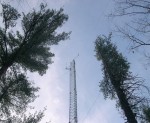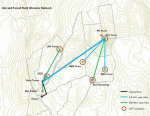The Harvard Forest Field Wireless Network (HFFW) became operational earlier this year with funding from the National Science Foundation (NSF), the Department of Energy (DOE), and Harvard University. Inspired by an NSF-sponsored workshop at Sevilleta in 2002 (see Network News, Fall 2002, p.10), and after years of planning and testing, the HFFW provides high speed network access to major research sites across Harvard Forest’s 375-ha Prospect Hill Tract.
The use of wireless networks in the field has many potential advantages for research and education. Scientists can monitor and control their equipment remotely and detect problems almost immediately. From their desktops, researchers can access real-time data for environmental modeling and forecasting. Students, too, can watch events unfold in real time.
In designing the HFFW we faced both challenges and advantages compared with other LTER sites that have implemented field wireless networks (Network News, Fall 2007, p. 1). Challenges included hills (which block wireless signals) and dense forest (which saps signal strength), the need for high network bandwidth (to accommodate a large number of users and data intensive experiments), and a desire to implement the HFFW as a part of the Harvard University network. Advantages included the existence of a fire tower and three eddy flux towers for relaying signals above the canopy, access to line power at the major experiments, and generous support from the University and its network engineers for the project.
Final design for the HFFW was achieved through partnership among Harvard Forest, Harvard Network Operations, and Silvian Technology Services. The physical layout takes advantage of existing towers (plus a new 40m relay tower) for line-of-sight transmissions between towers above the canopy as well as transmissions down through the canopy to surrounding experimental sites on the ground. Radios in two unlicensed frequency bands are used: 5.8 GHz for tower to tower (faster) and 900 MHz for tower to ground transmission (better canopy penetration).
Joining the Harvard University network required radios with VLAN support, which makes it possible to have separate virtual networks (e.g., data, voice, network management) over the same physical network. In the end we selected a carrier-grade line of radios (Alvarion BreezeAccess VL) because of their robust design and advanced features. At each major research site, radios are connected via Ethernet to a Cisco network switch and Wi-Fi access point. Since all this equipment requires line power, we decided to limit the HFFW itself to sites with power, though sensor networks and other extensions of the HFFW might be powered in other ways.
As part of the Harvard network, the HFFW takes advantage of core network functions for registration, management, and security. Remote access is enabled through a VPN (virtual private network). All major nodes (radios, switches, and access points) are continuously monitored and email alerts are sent whenever a node goes down. In its present form the HFFW includes three eddy flux towers, two global warming experiments, and a met station, but the network design is scalable to accommodate significant expansion in the future.
The HFFW is jointly administered by Harvard Forest and Harvard Network Operations. For more details, please see harvardforest.fas.harvard.edu/research/hffw.html.

 Enlarge this image
Enlarge this image
